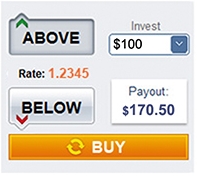The binary options market is known as one of the easiest to understand. Still, day in and day out, new options are being developed and added to the offer list. One of the new binary options type is the boundary option which enriches the already thrilling and entertaining market.
What is the Boundary Option?
This option offers two price levels; the upper and lower level, and both are determined by your broker. Your task is to predict if the price level of the asset of your choice will stay within the specified range or surpass that range. You also have the right to choose the expiry time by yourself, but be aware that the longer the timeframe, wider the boundaries.
How to Use the Boundary Option?
Log into your live trading account and pick an asset you want to trade. Afterwards, simply select an expiry time. You have two options at your disposal, namely “In” and “Out”. “In” is the option you choose when you believe that the asset will remain in the specified price range, and “Out” is the option you click if you think that the price will exceed the range. After you decided on the “In” or “Out” option, you enter the money amount you want to invest. All you have to do at that point is to wait until the trade reaches the expiry time and see if you have won. If you should win, the money will be immediately added to your account.
Strategic Approach
 Even if binary options appear to be the kind of trade which does not require a lot of thought, quite the contrary is the case. Binary options require a thorough market study, knowledge on assets and movements and the relevant strategies. Basically, a particular skill set has to be acquired to have a real shot for success. The same is true for this very type, i.e. boundary options! It also requires certain background knowledge and an analytical approach to predict the price ranges. One can start with following the news. Many traders make solid predictions based on what they hear on the news.
Even if binary options appear to be the kind of trade which does not require a lot of thought, quite the contrary is the case. Binary options require a thorough market study, knowledge on assets and movements and the relevant strategies. Basically, a particular skill set has to be acquired to have a real shot for success. The same is true for this very type, i.e. boundary options! It also requires certain background knowledge and an analytical approach to predict the price ranges. One can start with following the news. Many traders make solid predictions based on what they hear on the news.
The news might display some relevant information on a particular asset which will affect the asset price. Usually, when an asset makes it to the news, chances are that the price will drastically move (either up or down), which means that the asset price will probably surpass or drop below the specified range and your job is to call the Out option in such an event. When an asset price has been steady for a significant period and does not show major signs of fluctuation you might want to place the “In” option. These two examples show how to read the relevant information from the news and how to link it to the binary options market and make use of it.
Real-Life Examples of Boundary Option
1. Let’s use currency prices as an example here. Imagine that you are trading on the USD/EUR currency pair. The strike prices (the prices at the beginning and the end of the range) are 1,4327 at the higher end, and 1,4270 at the lower end. This kind of trade is usually a short-term trade (e.g. 15 min) given that the trading range is very tight. Let’s say you predict that the price will stay within the range and select the expiry date of 15 minutes. If the price does not surpass 1,4327, or drop below 1,4270, you will be able to collect your winnings from your account. An average payout rate for this kind of trade would be 60% on average. Nevertheless, bear in mind that the broker determines the payout rates and they can vary from broker to broker.
2. This example refers to a medium-term trade in stocks of, let’s say, for example, Apple. You are sure that the Apple stock will trade between $107 and $111 next week. If the price of Apple stock remains within this framework for an entire week, you certainly have a reason to celebrate, since you won the trade. However, if the stock should drop below $107 or surpass $111 in the given timeframe, you will lose your investment.
How to Trade Successfully?
Rely on the market conditions! Observe, read and watch the news and try to estimate the volatility factor. Volatility dictates prices and price ranges. You should concentrate on the price changes or volatility, and if you think that volatility of an asset will increase, place trades outside the given range. The same goes for the opposite, if you think that volatility of an asset is stable and will remain stable, click the “In” option. The only catch here is to learn how to “read” volatility and to set up an effective strategy.
| Broker | Bonus | More |
|---|---|---|

|
Check Website | Review |












